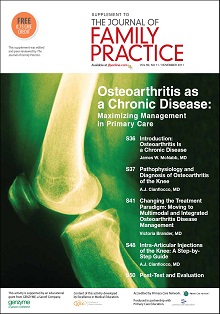User login
Osteoarthritis (OA) is the most common form of arthritis and a leading cause of disability worldwide. In the United States alone, it is believed that approximately 27 million people are affected by this degenerative condition. Many factors are known to increase the risk of developing OA, including heredity, obesity, joint or nerve injury, repeated overuse of certain joints, lack of physical activity, and aging. Treatment for OA needs to be individualized according to the stage of the disease, patient tolerability, comorbidities involved, and response to therapies to meet the goals of reducing pain, improving joint mobility and quality of life, and limiting functional impairment while avoiding drug toxicity. This supplement will review the latest advances in the pathogenesis, underlying phenotypes, and current therapeutic options of OA.
Click here to read Supplement.
Osteoarthritis (OA) is the most common form of arthritis and a leading cause of disability worldwide. In the United States alone, it is believed that approximately 27 million people are affected by this degenerative condition. Many factors are known to increase the risk of developing OA, including heredity, obesity, joint or nerve injury, repeated overuse of certain joints, lack of physical activity, and aging. Treatment for OA needs to be individualized according to the stage of the disease, patient tolerability, comorbidities involved, and response to therapies to meet the goals of reducing pain, improving joint mobility and quality of life, and limiting functional impairment while avoiding drug toxicity. This supplement will review the latest advances in the pathogenesis, underlying phenotypes, and current therapeutic options of OA.
Click here to read Supplement.
Osteoarthritis (OA) is the most common form of arthritis and a leading cause of disability worldwide. In the United States alone, it is believed that approximately 27 million people are affected by this degenerative condition. Many factors are known to increase the risk of developing OA, including heredity, obesity, joint or nerve injury, repeated overuse of certain joints, lack of physical activity, and aging. Treatment for OA needs to be individualized according to the stage of the disease, patient tolerability, comorbidities involved, and response to therapies to meet the goals of reducing pain, improving joint mobility and quality of life, and limiting functional impairment while avoiding drug toxicity. This supplement will review the latest advances in the pathogenesis, underlying phenotypes, and current therapeutic options of OA.
Click here to read Supplement.
